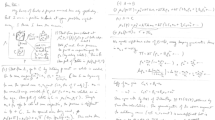Abstract
FOR almost as long as protoplasm has been recognized, some of its basic properties have been studied. Among these is the ‘self-sealing’ property or surface precipitation reaction. When a cell is broken, its contents do not diffuse into the surrounding medium but instead form discrete droplets. This reaction has been observed in many types of cells, but there has been little attempt to study it quantitatively. It would be highly desirable to know the amount of force required to break a cell; for if too much force is applied, the surface precipitation reaction may not be observed, since the cell is broken too quickly (for a discussion of the reaction, see refs. 1, 3).
Similar content being viewed by others
References
Heilbrunn, L. V., ‘The Colloid Chemistry of Protoplasm’ (Borntraeger, Berlin, 1928).
Cole, K. S., J. Cellular Comp. Physiol., 1, 1 (1932).
Heilbrunn, L. V., ‘The Dynamics of Living Protoplasm’, (Academic Press, 1956).
Heilbrunn, L. V., Wilson, W. L., Ashton, F. T., and Feldherr, C., Biol. Bull., 115, 459 (1958).
Author information
Authors and Affiliations
Rights and permissions
About this article
Cite this article
ASHTON, F. A Method for the Quantitative Study of the Surface Precipitation Reaction. Nature 184, 1735–1736 (1959). https://doi.org/10.1038/1841735a0
Issue Date:
DOI: https://doi.org/10.1038/1841735a0
- Springer Nature Limited





